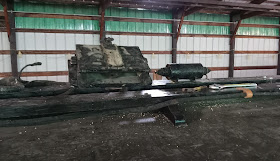Tuesday, January 31, 2023
Selling the Farm
Monday, January 30, 2023
Onward to July
After that, my attention turned to the trolley bases for the 460, which could use some servicing. Joel headed up disassembly of the first of the two trolley bases. He cleaned up the base bearing, which was not working very well, and I sand-blasted some of the component parts, as shown here.
We also used the Fullarton Spring Stretcher (patent pending) to expand two of the base springs a bit so that we could sand-blast and prime them. Here, Joel puts primer on the springs while they're mounted in the Spring Stretcher frame.
Meanwhile, as usual, progress was being made on other projects. The air compressor on Charles City Western steeplecab 300 flashed over last year, so Nick (above left) and Greg (right) took the end casting off the pump and removed the armature. We hoped that one of our spare armatures might be the right type, but no luck, so this armature will need to be sent out for rebuilding. Tim was also out, working on windows for the 1808, but I didn't get a photo of his work.
And at the end of the day, Nick finished up with painstakingly lettering the sign box for IT 415. Here he demonstrates the modern, polite way to tell people you don't want to listen to what they have to say. One of the priorities for the next few months will be getting the 415 into the Barn 2 spray booth, if at all possible, so that it can be painted and returned to service.
Saturday, January 28, 2023
Doerr Collection Additions
Thursday, January 26, 2023
Reset Switches
This is your place to find answers to technical questions about electric cars of all sorts. So....
The question came up recently on how the reset function works on our interurban cars, whether North Shore or CA&E. Most of them have a reset/power switch ("canopy switch") located above the controller. When in the center position, the control system is off; moving the handle to the right turns the controller on. When moved to the left, it will reset the overload relay if tripped, and there's a spring return so the switch cannot be left in the reset position. And you can reset only by turning the control system off.
Note that this reset switch should reset the overload relays on all cars in the train. The way that works depends upon the particular type of control system. Below is a simplified HL diagram for Westinghouse.
In the center at top, the reset switch applies power either to the controller, or to line 8. And line 8 is part of the control jumper, so it connects to all cars in the train. Lower down and to the left, we see the reset coil for the overload relay, which is connected to line 8. So that's pretty simple.
For cars with General Electric MU control, such as the CA&E steel cars, it's a little more complicated. Here is the simplified diagram for C-165.
Wednesday, January 25, 2023
Tuesday Testimonial
Another busy Tuesday at the Museum results in more progress on our long-term projects. While this may not be as crowd-pleasing as our winter weekend celebrations, it's what we've got today.
Around the shop, we see all the many parts that need to be restored piece by piece. These are the window shade tracks, as I call them, for the 306.
Tuesday, January 24, 2023
New Year Freight Update
Buzz Morisette reports on some of the recent work by the Freight Car Department:
The PRR Bobber cabin car is almost completed. In the fall, Victor and Buzz lettered the new exterior paint. The stove has the new custom-built damper installed.
What remains is to replace the bent brake rigging. We have a replacement, but await some help from the Steam Shop to install it. Victor is working up a Rail and Wire article for this project, so stay tuned.
Buzz and Bill have been working on the MILW X-5001 Business Car. Now that it is inside, we have been finally addressing the extensive wood rot on the interior walls.
Bill is shown here cleaning up after the removal of a soft spot above the table.
One whole wall next to the bunks had to be replaced.
After repairs the wall receives a plywood veneer to match the 1970 rebuild.
Fresh interior paint was put on in the fall after the rebuilt sash windows, sills, and trim.
When it's too cold to work out in the barn, Buzz has been rebuilding the Mid-Century Modern lighting that was original to the 70s Milwaukee Shops rebuild. All are 12 volt and have been converted to less power-hungry LEDs.
Up on the roof three new (simple freight) saddles, featured in a previous post, are in the process of being bolted through.
P.S. The only North Shore photo I have worth posting was of the five-car train just before departure after dusk.
Milwaukee 441 Update
Monday, January 23, 2023
North Shore Line at Night, Part IV
More photographs from Matt Gustafson.
All images are copyright by the photographer and may not be reproduced without permission.









































.jpeg)
.jpeg)
.jpeg)
.jpeg)






